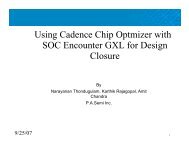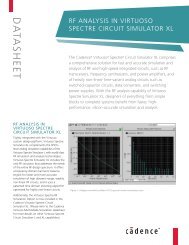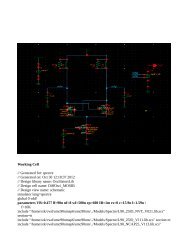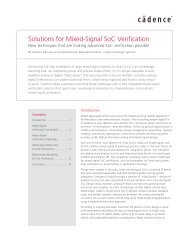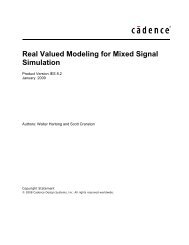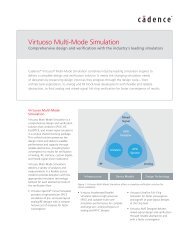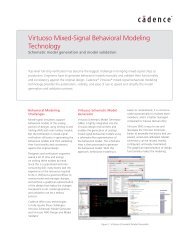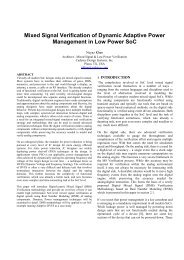Solutions for Mixed-Signal SoC Implementation - Cadence Design ...
Solutions for Mixed-Signal SoC Implementation - Cadence Design ...
Solutions for Mixed-Signal SoC Implementation - Cadence Design ...
You also want an ePaper? Increase the reach of your titles
YUMPU automatically turns print PDFs into web optimized ePapers that Google loves.
Digital timing verification<br />
The verification of digital timing paths inside mixed-signal blocks is problematic in traditional netlist-driven flows.<br />
Typically, digital implementation tools extract path parasitics only to the analog IP block’s instance pin, and any<br />
loading inside the block is modeled by a .lib file (Figure 7, left). Generating that .lib file amounts to a generally<br />
painful experience <strong>for</strong> analog designers.<br />
A better approach provided by the Encounter Digital <strong>Implementation</strong> system involves extracting full-path parasitics<br />
all the way to the digital instance pin (Figure 7, right). The tool models the loading of the digital path inside a<br />
mixed-signal block as a distributed RC network. Internal loading is thus appended to the extracted path, and<br />
static timing analysis can verify the complete path with no need to generate a .lib file.<br />
Digital<br />
I1 I2<br />
Path parasitics<br />
extracted to<br />
AMS instance pin<br />
Digital cell library instances<br />
AMS AMS Partition .lib<br />
Towards a new mixed-signal implementation flow<br />
Digital<br />
I1<br />
Extract full path<br />
parasitics to digital<br />
instance pin<br />
Figure 7: Extracting full-path parasitics allows timing closure on<br />
mixed-signal blocks without requiring generation of a .lib file.<br />
<strong>Solutions</strong> <strong>for</strong> <strong>Mixed</strong>-<strong>Signal</strong> <strong>SoC</strong> <strong>Implementation</strong><br />
I2<br />
AMS Partition<br />
The schematic-driven and netlist-driven flows are block-based approaches that involve the import of one type of<br />
block into a larger analog or digital environment. The emerging mixed-signal flow represents a much more integrated<br />
methodology. While the new flow retains separate analog and digital design teams and tools, responsibility <strong>for</strong> the<br />
overall design, verification and chip tapeout is shared.<br />
One big advance with this new approach is that analog and digital blocks can be designed concurrently. Floorplanning<br />
can be truly mixed-signal, with flexibility to assign or optimize pins. With flexible pinouts, designers do not need to<br />
send analog or digital blocks back <strong>for</strong> rework if they find that fixed pinouts don’t work in a floorplan. Results can include<br />
earlier floorplanning, smaller area, less routing congestion, earlier chip finishing, and faster overall turn-around times.<br />
Figure 8 shows an advanced mixed-signal implementation flow. Notice how the top-level floorplan becomes a joint<br />
exercise between analog and digital design groups. These teams concurrently optimize the floorplan, changing<br />
pinouts and locations and routing nets as needed, until they can both sign off on the floorplan. Each team must be<br />
aware of the constraints on the other side.<br />
www.cadence.com 8






